In relation to both the discussion regarding the visualization of sound/music as well as the work that Ghalya has posted about EJTECH’s work, I wanted to share this project because, well, it looks really cool. The project uses a speaker attached to a metal plate which moves sand that is placed on top of it when notes are played. It’s pretty visually interesting, and might be cool inspiration for something.
Author: Alex Lin
Honk Detector
Problem:
Not being able to hear when another vehicle is honking at you, or something else or from which direction that honk is coming from.
A General Solution:
A device that would visually notify the driver that someone is honking and from which direction that honk is coming from.
Proof of Concept:
An Arduino with sound detectors and LEDs/a visual interface. When a sound above a certain volume is heard by the sound detectors, the corresponding LED lights up. If the same volume (with some tolerance) is picked up by both sound detectors, both LEDs light up. On a more realistic level, there would be detection for every direction away from the “vehicle” which would require more sensors.
Fritzing Sketch:
The Fritzing sketch shows how the sound detectors would input information to the Arduino as well as how the LEDs (in this case) would be connected to the output pins. I could not find the piece for the sound detectors in the Fritzing library so I replaced the sound detectors with potentiometers because the sound detectors can input analog data which would be more helpful than digital data in this scenario. Not pictured, is that the Arduino would have to be connected to some battery source.
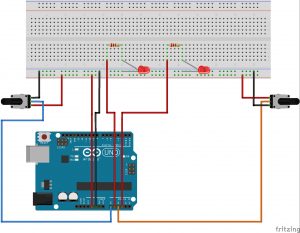
Proof of Concept Sketches:
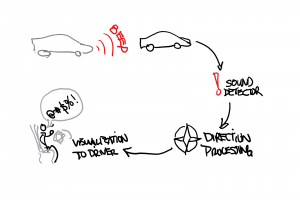
The flow of data starts with a car honking at the user’s vehicle, reaching the sound detector which then feeds an analog input into the Arduino which will decide which direction the sound is coming from. It will then turn on the corresponding LED or visualization to notify the driver that someone is honking at or near them.
Proof of Concept Videos:
Prototype:
Tolerance Study:
Files:
Micro Wave
Simple State Machine:
A microwave has multiple states: OFF, COOKING, and DONE, ALERT USER. Part of this system is that by opening the door of the microwave, the cooking and alerting user states can be stopped.
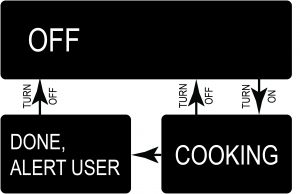
Problem:
For those who are deaf or are hard of hearing, knowing when a microwave is done cooking is not perceived because normally the microwave beeps to notify the user.
General Solution:
A visualization means that would inform a user of the state that the microwave is in even when they aren’t watching the microwave itself.
Proof of Concept:
A Sparkfun Redboard Turbo with a potentiometer and switch. The potentiometer allows the user to control the amount of time the microwave is cooking. The switch allows the user to start and stop the microwave. In this case, the LED embedded in the Sparkfun Redboard Turbo board will be used to represent the state of the microwave.
Fritzing Sketch:
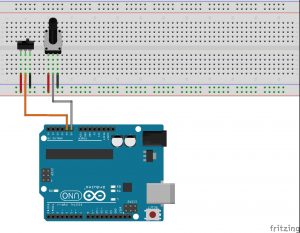
The Fritzing sketch shows diagrammatically how the Sparkfun Redboard Turbo would be connected to the potentiometer and switch. Not pictured is the LED embedded light on the actual Sparkfun Redboard that would be operated through code.
Video:
Files:
Hey Mi
Problem:
Not being able to hear when someone is calling your name/trying to get your attention, whether in the context of a workplace, airport, etc.
A General Solution:
A device that would physically or visually notify an individual when sensing that someone is trying to get their attention.
Proof of Concept:
An Arduino with a microphone/other device with a microphone and LEDs/Servo. Specific words cause the LEDs to flicker/Servo to make movements to grab the individual’s attention. and plays a sample on the speaker stating the status of a configuration. Example: when sensing that the user’s name is being called, the device will flicker/move.
Fritzing Sketch:
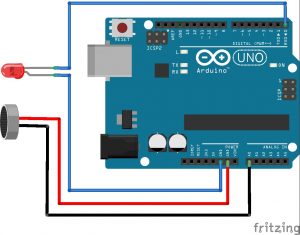
The Fritzing sketch shows diagrammatically how the microphone would input information to the Arduino as well as how the LED/Servo would be connected to the output pins. Not pictured, is that the Arduino would have to be connected to some battery source.
Arduino Sketch:
I’m not familiar with voice recognition with Arduino, but I found a project that has done it before with specific hardware (link here) and there are other devices that surround us that would be able to accomplish the same audio processing as well (ex. smartphones, smart watches). The results of the audio processing would trigger a digital output to the LEDs/Servo to communicate to the user.
Proof of Concept Sketches:

The flow of data starts with outside audio reaching the microphone which then is fed into the Arduino (or other audio processing capable device) which will decide whether or not to send a signal to the LED/Servo/solenoid based on whether the sound recognizes the users name. If the name is recognized, the signal is sent and it grabs the user’s attention.
Responses & First Thoughts
Tom Igoe:
While I definitely understand the critique of many of the physical computing themes, I suppose my only concern about disregarding or looking down upon the themes can be counterproductive when trying to design better solutions for solving problems. Although perhaps one, two, or maybe three of the themes might be a Frankenstein of a project, I wonder if by combining multiple aspects of multiple themes or even implementing some aspect of one of the themes could ultimately help a new project interface with a user. I guess what I mean is that the discussed themes can be boring when they’re repeated over and over, they might have something to offer a project that has hit a brainstorming/troubleshooting roadblock.
Descendants:
The short story presents an interesting take on human reliance on technologies that, in at least some regard, are objectively better, smarter, stronger, or more efficient. After a devastating crash, the individual and the suit are thrust upon a tireless never-ending journey through an unforgiving planet. What is interesting, and also representative of humanity to an extent, is the habit of the individual to complain. The heat, the sweat, the smell, and every bit of discomfort is detailed throughout the individual’s journey. This isolates a very critical part of humanity, our insistence on not adapting, that there is a way to solve problems and to adjust for what we aren’t capable of or aren’t designed to do. And this also presents an intriguing dichotomy of humans discarding technology as soon as there is better in contrast with technology being designed to cover for all of our deficiencies.
The story also focuses on the interaction between the human and the suit. One party experiencing a organic concoction of pain, desire, and confusion with the other sensing what is physically, mechanically, and chemically possible in the former. This disconnect leads to two paths, one which points out the lack of appreciation, at times, of what we have and what is made possible through technology, and another which defines a critical issue when interacting with technology in the complexity of communication that must be felt and sensed.
And last thing, I thought this quote was interesting:
“We created something a little closer to perfection than ourselves; maybe that’s the only way to progress” (63)
In creating things that are closer to perfection compared to ourselves, are we bridging that disconnect? I wonder about when that disconnect disappears, does technology cease to exist? Do it merge with us and do we become one entity?
Related Skills:
I have taken an Architecture course dealing with accessibility called Human Factors in which we studied, among other related topics, how various places on- and off-campus are architecturally hostile and exclusive to someone in a wheelchair. I have had experience in theater and acting in high school, which has been a smaller part of my experience in university. In regards to digital fabrication, I’m familiar with laser cutting, CNC-ing, and operating architectural robots.